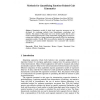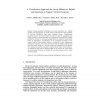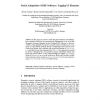HCI
2009
13 years 10 months ago
2009
Quantitative models of whole body expressive movement can be developed by combining methods form biomechanics, psychology, and statistics. The purpose of this paper was to use moti...
HCI
2009
13 years 10 months ago
2009
Games are increasingly being used as educational tools, in part because they are presumed to enhance student motivation. We look at student motivation in games from the viewpoint o...
HCI
2009
13 years 10 months ago
2009
HCI
2009
13 years 10 months ago
2009
In this paper, we describe lexical rule-based approach to affect sensing from text, and application of the developed Affect Analysis Model in 3D virtual world Second Life. To enric...
HCI
2009
13 years 10 months ago
2009
During persistent surveillance of a given population in a conflict situation, data management can quickly become unwieldy due to the inundation of low-level information from many, ...
HCI
2009
13 years 10 months ago
2009
Game developers have begun applying formal human-computer interaction (HCI) principles in design. Desurvire et al [2] adapted a set of Heuristics for productivity software to games...
HCI
2009
13 years 10 months ago
2009
Abstract. In this paper we present a newly designed annotation and collaboration component, which has been prototypically implemented on top of an ERP (Enterprise Resource Planning...
HCI
2009
13 years 10 months ago
2009
It becomes more difficult to find valuable contents in the Web 2.0 environment since lots of inexperienced users provide many unorganized contents. In the previous researches, peop...
HCI
2009
13 years 10 months ago
2009
In the Web 2.0 era, people not only read web contents but upload, view, share and evaluate all contents on the web. This leads us to introduce a new type of social network that is ...
HCI
2009
13 years 10 months ago
2009
Virtual communities that make use of social network site features blend known applications of virtual communities. These communities can be simultaneously social and commercial, or...



